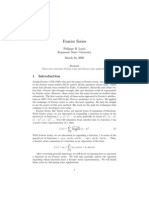Fourier Series: Graphs of y A Sin NX
Fourier Series: Graphs of y A Sin NX
Uploaded by
Siti Zulaiha UyubCopyright:
Available Formats
Fourier Series: Graphs of y A Sin NX
Fourier Series: Graphs of y A Sin NX
Uploaded by
Siti Zulaiha UyubOriginal Description:
Original Title
Copyright
Available Formats
Share this document
Did you find this document useful?
Is this content inappropriate?
Copyright:
Available Formats
Fourier Series: Graphs of y A Sin NX
Fourier Series: Graphs of y A Sin NX
Uploaded by
Siti Zulaiha UyubCopyright:
Available Formats
PART I:
1.0
FOURIER SERIES
Introduction
Fourier series are series of cosine and sine terms and arise in the important practical task of representing general periodic functions. They constitute a very important tool in solving problems that involve ordinary and partial differential equations.(1)
1.1
Periodic Functions and Trigonometric Series.
Definition 1 A function f(x) is said to be periodic if its function values repeat at regular intervals of the independent variable. The regular interval between repetitions is the period of the oscillations.
Definition 2 A function f(x) is called periodic if it is defined for all real x and if there is some positive number p such that, for all x,
The number p is called a period of f(x). The graph of such a function is obtained by periodic repitition of its graph in any interval of length p. Periodic phenomena and functions occur in many applications. Examples of periodic functions are sine and cosine functions, the function f = c = constant (because it satisfies the condition for every positive p). Examples of functions that are not periodic are and .
Example 1 Graphs of y = A sin nx i. y = sin x
ii.
y = 5 sin 2x i. The amplitude is 5 ii. The period is 180 and there are two complete cycles in 360
iii.
y = A sin nx Amplitude Period No. of cycles in 360 = = = ................. ................. .................
How about graphs of y = A cos nx ?
Exercise 1 State the amplitude and the period for the following functions.
i. ii. iii. iv. v. vi. vii. viii.
y = 3 sin 5x y = 2 cos 3x
y = 4 sin 2x y = 5 cos 4x y = 2 sin x y = 3 cos 6x
Definition 3 (Harmonics) A function f(x) is sometimes expressed as a series of a number of different sine components. The component with the largest period is the first harmonic, or fundamental of f(x).
Example 2
is the first harmonic or fundamental is the second harmonic
is the third harmonic is the ............. harmonic with ............. amplitude and period ..............
Definition 4 (Non-sinusoidal periodic functions) A function can be periodic without being sinusoidal in appearance.
Example 3
Period = 8 ms
Period = ?
Period = ?
Definition 5 A periodic function can be defined analytically in many cases.
Example 4 i.
ii.
iii.
Exercise 2 Define analytically the periodic functions below.
Exercise 3 Sketch the graphs of the following functions:
i. {
ii.
iii.
iv.
v. {
1.2
Fourier Series for periodic functions of period 2
From the definition of a periodic function, it can be seen that
[ ]
and, for any integer n,
Therefore 2p, 3p, 4p, ... are also periods of f(x). If f(x) and g(x) have periods p, then the function
also has the period p. Some simple functions period p = 2 are 1, cos x, sin x, cos 2x, sin 2x, ... , cos nx, sin nx, ...
These functions will be used as representation of various functions of period p = 2. A trigonometric series of the form below will arise from this connection:
where a0, a1, a2, ... ,b1, b2, b3, ... are real constants. The an and bn are called the coefficients of the series. This series has the period 2, and if the series converges, its sum will be a function of period 2.
Definition 6 A Fourier series is to represent periodic function by trigonometrical series of the form
where A0 is a constant term; c1, c2, c3, ..., cn denote the amplitudes of the compound sine terms; 1, 2, 3, ... are constant auxiliary angles. In the definition, nth harmonic of f(x). Each sine term, is the fundamental or first harmonic of f(x) and, is the
can be expanded as
Finally, the whole series becomes
where n is a positive integer.
1.2.1
Fourier Coefficients
Definition 7 The Fourier coefficients can be obtained by the following formulas:
Example 5 Determine the Fourier series to represent the periodic function shown.
Example 6 Find the Fourier series for the function shown.
Example 7 Find the Fourier Series for the function defined by
1.2.2
Odd and Even Functions
Definition 8 (Even function) A function f(x) is said to be even if f(-x) = f(x) The function value for a particular negative value of x is the same as that for the corresponding positive value of x. The graph of an even function is therefore symmetrical about the y-axis.
Definition 9 (Odd function) A function f(x) is said to be odd if f(-x) = -f(x) The function value for a particular negative value of x is numerically equal to that for the corresponding positive value of x but opposite in sign. The graph of an odd function is thus symmetrical about the origin.
Example 8
Example 9
Example 10
Definition 10 Products of odd and even functions are as follow: (even) (even) = (even) (odd) (odd) = (even) (odd) (even) = (odd)
Theorem 1 If f(x) is defined over the interval - < x < and f(x) is even, the the Fourier series for f(x) contains cosine terms only.
Theorem 2 If f(x) is an odd function defined over the interval - < x < , the the Fourier series for f(x) contains sine terms only.
1.3
Half-Range Series
Sometimes a function of period 2 is defined over the range 0 to , instead of the normal to or 0 to 2. Then, there are three types of Fourier series that can be derived. For example, if between x = 0 and x = , f(x) = 2x, the period is 2 but there is no evidence of how the function behaves between x = - and x = 0.
If the waveform were as in (a), the function can be an even function, symmetrical about the y-axis, and the series would have only cosine terms (including possibly a0).
On the other hand, if the waveform were as in (b), the function would be odd, being symmetrical about the origin and the series would have only sine terms.
Of course, if something quite different was chosen, such as in (c), for the waveform between x = - and x = 0, then f(x) will neither be odd nor even and the series will then contain both sine and cosine terms (including a0).
Example 11 A function f(x) is defined by
{
Obtain a half-range cosine series to represent the function.
Example 12 Determine a half-range sine series to represent the function f(x) is defined by
{
1.4
Functions with periods other than 2
In practice, functions defined over periodic intervals other than 2 are often encountered. For example, from 0 to T, to .
1.4.1
Functions with period T to , that is has a period T, then this can be converted to an
If y = f(x) is defined in the range
interval of 2 by changing the units of the independent variable. In many practical cases involving physical oscillations, the independent variable is time (t) and the periodic interval is normally denoted by T, that is
Each cycle is therefore completed in T seconds and the frequency f hertz (oscillations per second) of the periodic function is therefore given by defined by , then . If the angular velocity, radians per second, is
The angle, x radians, at any time t is therefore function can be expressed as which can also be written in the form for n = 1, 2, 3, ...
and the Fourier series to represent the
1.4.2
Fourier coefficients
With the new variable, the Fourier coefficients become where
The limits can be 0 to T, complete period.
to
to
, 0 to
etc as is convenient, as long as they cover a
Example 13 Determine the Fourier Series for a periodic function defined by
{
1.4.3
Half-range series
The theory behind the half-range sine and cosine series still applies with the new variable. (a) Even function Half-range cosine series
{
symmetrical about the y-axis. With an even function, bn = 0, and where
(b)
Odd function Half-range sine series
{
symmetrical about the origin. With an even function, a0 = 0 and an = 0, and where
Example 14 A function f(t) is defined by f(t) = 4 t, 0 < t < 4. Find the half-range cosine series to represent this function.
Example 15 A function f(t) is defined by
{
Obtain the half-range sine series for the function in this range.
You might also like
- Introduction To Fourrier AnalysisDocument28 pagesIntroduction To Fourrier AnalysisWashington BrownNo ratings yet
- Gecolea, Jazztine Andrei A. ME50-2/A1:, X, E, Cosh X, and LN X, To Mention Just A FewDocument4 pagesGecolea, Jazztine Andrei A. ME50-2/A1:, X, E, Cosh X, and LN X, To Mention Just A FewJazztine Andrei GecoleaNo ratings yet
- The Fourier SeriesDocument124 pagesThe Fourier SeriesSarwendaNo ratings yet
- Definition of Fourier Series and Typical ExamplesDocument17 pagesDefinition of Fourier Series and Typical ExamplesAura Paige Montecastro-RevillaNo ratings yet
- Chapter 11 Fourier Analysis PDFDocument165 pagesChapter 11 Fourier Analysis PDFjohnhenryyambaoNo ratings yet
- Cse Iii Engineering Mathematics Iii 10mat31 Notes PDFDocument138 pagesCse Iii Engineering Mathematics Iii 10mat31 Notes PDFPPatilNo ratings yet
- Chapter 11 Fourier Analysis NewDocument165 pagesChapter 11 Fourier Analysis NewMohammed Al-OdatNo ratings yet
- Tangent (Geometry) : Tangent To A Curve. The Red Line Is Tangential To The Curve at The Point Marked by A Red DotDocument41 pagesTangent (Geometry) : Tangent To A Curve. The Red Line Is Tangential To The Curve at The Point Marked by A Red DotabhishekNo ratings yet
- Ch11 14 PDFDocument77 pagesCh11 14 PDF王大洋No ratings yet
- Lecture 17 MTH343Document60 pagesLecture 17 MTH343Nguyễn Quang HuyNo ratings yet
- Transformation FourierDocument3 pagesTransformation FourierTanvir Ahmed DipNo ratings yet
- Fourier SeriesDocument28 pagesFourier SeriesFrancis LebadesusNo ratings yet
- Proof: Euler S TheoremDocument20 pagesProof: Euler S TheoremNeelam ChauhanNo ratings yet
- Fismat 371 380Document16 pagesFismat 371 380Yogi Firman AndikaNo ratings yet
- Problems Based Exponential and Trigonometric Fourier Series and Its ApplicationsDocument9 pagesProblems Based Exponential and Trigonometric Fourier Series and Its ApplicationsKhushbu ThakurNo ratings yet
- Function of Several Real VariablesDocument14 pagesFunction of Several Real VariablesJose Luis CondoriNo ratings yet
- The Fundamental Postulates of Quantum MechanicsDocument11 pagesThe Fundamental Postulates of Quantum MechanicsMohsin MuhammadNo ratings yet
- Fourier Series & Fourier Transforms: SynopsisDocument11 pagesFourier Series & Fourier Transforms: SynopsisSafiun NaharNo ratings yet
- Fourier Series' & Itsapplication'Document27 pagesFourier Series' & Itsapplication'MEET CHAJJEDNo ratings yet
- Fourier SeriesDocument20 pagesFourier SeriesMichel OlveraNo ratings yet
- Fourier Series, Sine Series, Cosine SeriesDocument9 pagesFourier Series, Sine Series, Cosine SeriesXinglong ZhangNo ratings yet
- 1.fourier SeriesDocument11 pages1.fourier SeriesAtikah JNo ratings yet
- CUHK MATH 3060 Lecture Notes by KS ChouDocument98 pagesCUHK MATH 3060 Lecture Notes by KS ChouAlice YuenNo ratings yet
- Tuesday September 13: (Refers To Section 1.2 To 1.5 in Your Text)Document4 pagesTuesday September 13: (Refers To Section 1.2 To 1.5 in Your Text)S>No ratings yet
- Fourier Methods and PDEsDocument20 pagesFourier Methods and PDEsMISKIR TADESSENo ratings yet
- Fourier Series and Fourier TransformsDocument13 pagesFourier Series and Fourier TransformsbjayachanderraoNo ratings yet
- Fourier Series: Philippe B. Laval Kennesaw State University March 24, 2008Document26 pagesFourier Series: Philippe B. Laval Kennesaw State University March 24, 2008Tae Hyun HwangNo ratings yet
- Calculating Fourier SeriesDocument14 pagesCalculating Fourier Seriesapi-3747235No ratings yet
- Using MATLAB To Generate Waveforms, Plotting Level Curves and Fourier Expansions. Task 1Document5 pagesUsing MATLAB To Generate Waveforms, Plotting Level Curves and Fourier Expansions. Task 1Freddy BelizarioNo ratings yet
- Convexity and Differentiable Functions: R R R R R R R R R R R R R R R RDocument5 pagesConvexity and Differentiable Functions: R R R R R R R R R R R R R R R RhoalongkiemNo ratings yet
- Module-2 Fourier SeriesDocument28 pagesModule-2 Fourier Seriespugalgopal7No ratings yet
- Chapter 1Document36 pagesChapter 1simoncho20050110No ratings yet
- F-X Linear Prediction Filtering of Seismic ImagesDocument19 pagesF-X Linear Prediction Filtering of Seismic ImagesAku PeguNo ratings yet
- 4.1 Fourier Sine and Cosine SeriesDocument12 pages4.1 Fourier Sine and Cosine SeriesbbteenagerNo ratings yet
- Periodic FunctionDocument5 pagesPeriodic FunctionBashir HussainNo ratings yet
- Calculus Iii: CHAPTER 6: Short Introduction To Fourier SeriesDocument17 pagesCalculus Iii: CHAPTER 6: Short Introduction To Fourier SeriesRoy VeseyNo ratings yet
- Problems: TABLE 10.2.1 Values of The Error eDocument10 pagesProblems: TABLE 10.2.1 Values of The Error edinizobardoNo ratings yet
- WWW - Math.iitb - Ac.in/ Swapneel/207: Partial Differential EquationsDocument198 pagesWWW - Math.iitb - Ac.in/ Swapneel/207: Partial Differential EquationsSpandan PatilNo ratings yet
- Fundition ChaosDocument25 pagesFundition ChaosRogério da silva santosNo ratings yet
- Mast10006 Calculus 2 Notes - CompressDocument59 pagesMast10006 Calculus 2 Notes - CompressAlanxujian123No ratings yet
- Notes-PDE pt2 - 2 PDFDocument27 pagesNotes-PDE pt2 - 2 PDFFirman ErizalNo ratings yet
- Fourier Series With ProblemsDocument30 pagesFourier Series With ProblemsAnuraj N VNo ratings yet
- Almost Periodic Functions in Terms of Bohr'sDocument23 pagesAlmost Periodic Functions in Terms of Bohr'shaifa ben fredjNo ratings yet
- NUS - MA1505 (2012) - Chapter 6Document27 pagesNUS - MA1505 (2012) - Chapter 6Gilbert SebastianoNo ratings yet
- Fourier SeriesDocument24 pagesFourier Serieseugeni madaNo ratings yet
- Functional Series. Pointwise and Uniform ConvergenceDocument17 pagesFunctional Series. Pointwise and Uniform ConvergenceProbenEksNo ratings yet
- Mathematical Techniques For Economic Analysis: Australian National University DR Reza HajargashtDocument60 pagesMathematical Techniques For Economic Analysis: Australian National University DR Reza HajargashtWu YichaoNo ratings yet
- Fourier SeriesDocument44 pagesFourier SeriesSilverblack ManNo ratings yet
- Fourierov Red: e X X X NDocument9 pagesFourierov Red: e X X X NadawdawdNo ratings yet
- Fourier SeriesDocument36 pagesFourier SeriesChrisWaltz100% (1)
- Ch3 Signals and SystemsDocument77 pagesCh3 Signals and Systemsanirudhapatil837No ratings yet
- Fourier Series Edited Notes 2022 - 23Document24 pagesFourier Series Edited Notes 2022 - 23Lukonde KangwaNo ratings yet
- Circular Convolution On MatlabDocument5 pagesCircular Convolution On Matlababhilash1889No ratings yet
- Het 213 L4Document40 pagesHet 213 L4mackydhobsNo ratings yet
- Ito ShitDocument35 pagesIto ShitNg Ze AnNo ratings yet
- Mathematics-Ii: Prepared By: Ms. K. Rama Jyothi,: Mr. G Nagendra KumarDocument118 pagesMathematics-Ii: Prepared By: Ms. K. Rama Jyothi,: Mr. G Nagendra KumarNithya SridharNo ratings yet
- Elgenfunction Expansions Associated with Second Order Differential EquationsFrom EverandElgenfunction Expansions Associated with Second Order Differential EquationsNo ratings yet
- Revision Plan-II (DPP # 1) - Mathematics - EnglishDocument4 pagesRevision Plan-II (DPP # 1) - Mathematics - EnglishBhriguKansraNo ratings yet
- Derivo Derivo Mini Sizing Support Chart - 410 - 1630501594Document2 pagesDerivo Derivo Mini Sizing Support Chart - 410 - 1630501594jegolezNo ratings yet
- Grade 5 Atp 2023-24 Mathematics With DatesDocument4 pagesGrade 5 Atp 2023-24 Mathematics With DatesnareNo ratings yet
- 167 - 1A, MIL-STD, Mechanical Vibrations of Shipboard EquipmentDocument23 pages167 - 1A, MIL-STD, Mechanical Vibrations of Shipboard Equipmenthasmit1No ratings yet
- Dry FrictionDocument18 pagesDry FrictionMohd Azhari Mohd RodziNo ratings yet
- EE6403-Discrete Time Systems and Signal ProcessingDocument17 pagesEE6403-Discrete Time Systems and Signal ProcessingBakru TheenNo ratings yet
- Flow Meter: FHKSC Arnite Using Fastening Pin Integrated R1,2K Pull-Up ResistorDocument9 pagesFlow Meter: FHKSC Arnite Using Fastening Pin Integrated R1,2K Pull-Up ResistorArvin Jay de LeonNo ratings yet
- Design of CouplingDocument18 pagesDesign of CouplingHarikrishna ShenoyNo ratings yet
- Working Strength Design (WSD)Document3 pagesWorking Strength Design (WSD)Honorio Joshua P.No ratings yet
- HL Portfolio WorkDocument76 pagesHL Portfolio WorksnipripNo ratings yet
- Natural Convection LatestDocument35 pagesNatural Convection LatestPradyumna DhamangaonkarNo ratings yet
- Properties of Section Described by Nodes CoordinatesDocument4 pagesProperties of Section Described by Nodes CoordinatesFranklyn GenoveNo ratings yet
- Fundamentals of Twin-Screw Extrusion Polymer Melting: Common Pitfalls and How To Avoid ThemDocument6 pagesFundamentals of Twin-Screw Extrusion Polymer Melting: Common Pitfalls and How To Avoid ThemPrasanth VeeraNo ratings yet
- Resettable Crash Sensors: BenefitsDocument2 pagesResettable Crash Sensors: BenefitsJohn ByroNo ratings yet
- Ge BWR4Document119 pagesGe BWR4rs_sechiNo ratings yet
- GGTN MarchDocument8 pagesGGTN MarchSai PhanindraNo ratings yet
- St7018 Stability of Structures L T P CDocument1 pageSt7018 Stability of Structures L T P Camma83233% (6)
- Computers and Structures: O.A. González-Estrada, J.J. Ródenas, S.P.A. Bordas, E. Nadal, P. Kerfriden, F.J. FuenmayorDocument10 pagesComputers and Structures: O.A. González-Estrada, J.J. Ródenas, S.P.A. Bordas, E. Nadal, P. Kerfriden, F.J. Fuenmayorbrian sanmbranoNo ratings yet
- Pipe Friction Loss TableDocument5 pagesPipe Friction Loss TableGan Penton100% (1)
- Lab 1Document13 pagesLab 1Chris RamosNo ratings yet
- Basic Operation of A LatheDocument6 pagesBasic Operation of A LatheRex GalichaNo ratings yet
- 00535403Document13 pages00535403ashish_rewaNo ratings yet
- MCQsDocument10 pagesMCQsyasirjurabaNo ratings yet
- (Prestressed Concrete) Lecture 05 Dr. ZubairDocument62 pages(Prestressed Concrete) Lecture 05 Dr. ZubairAhmed RiadNo ratings yet
- Question Bank Class 8 Science Force & PressureDocument5 pagesQuestion Bank Class 8 Science Force & PressureSamyak Goyal100% (1)
- Columns & StrutsDocument23 pagesColumns & StrutsAshish MaheshwariNo ratings yet
- R&P Practice PDFDocument4 pagesR&P Practice PDFPankaj Barick100% (1)
- DLC3010 Digital LevelDocument16 pagesDLC3010 Digital LevelAnonymous zTUWsMNo ratings yet
- Mech-Vi-Design of Machine Elements II (10me62) - Question PaperDocument11 pagesMech-Vi-Design of Machine Elements II (10me62) - Question PaperAnonymous utfuIcnNo ratings yet
- Hydroboration Oxidation or (1R) (+) Alpha PineneDocument4 pagesHydroboration Oxidation or (1R) (+) Alpha Pinenewilso279100% (1)

























































































